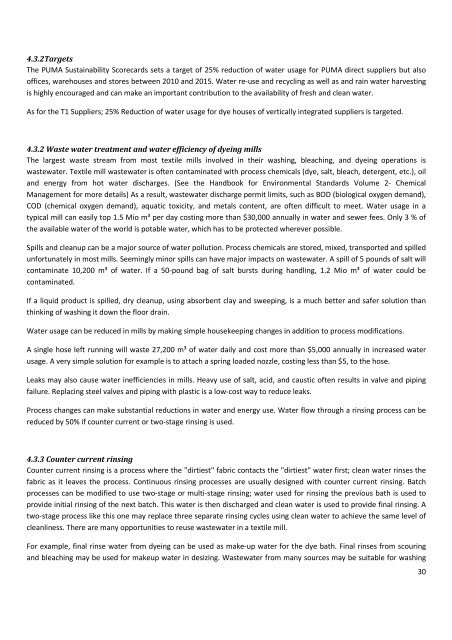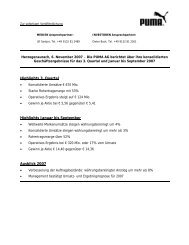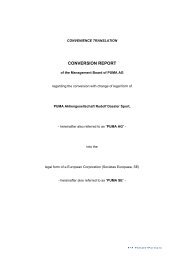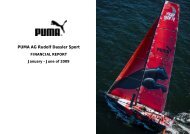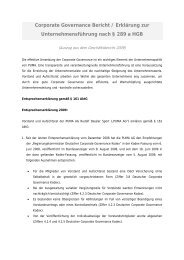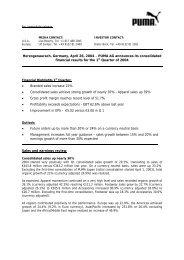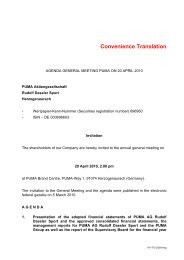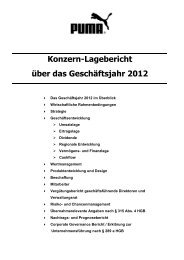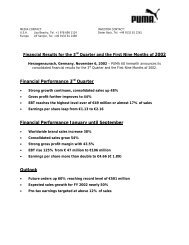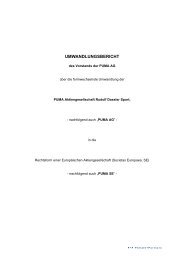PUMA.Safe Environmental Handbook Volume 1 - About PUMA
PUMA.Safe Environmental Handbook Volume 1 - About PUMA
PUMA.Safe Environmental Handbook Volume 1 - About PUMA
Create successful ePaper yourself
Turn your PDF publications into a flip-book with our unique Google optimized e-Paper software.
4.3.2Targets<br />
The <strong>PUMA</strong> Sustainability Scorecards sets a target of 25% reduction of water usage for <strong>PUMA</strong> direct suppliers but also<br />
offices, warehouses and stores between 2010 and 2015. Water re-use and recycling as well as and rain water harvesting<br />
is highly encouraged and can make an important contribution to the availability of fresh and clean water.<br />
As for the T1 Suppliers; 25% Reduction of water usage for dye houses of vertically integrated suppliers is targeted.<br />
4.3.2 Waste water treatment and water efficiency of dyeing mills<br />
The largest waste stream from most textile mills involved in their washing, bleaching, and dyeing operations is<br />
wastewater. Textile mill wastewater is often contaminated with process chemicals (dye, salt, bleach, detergent, etc.), oil<br />
and energy from hot water discharges. (See the <strong>Handbook</strong> for <strong>Environmental</strong> Standards <strong>Volume</strong> 2- Chemical<br />
Management for more details) As a result, wastewater discharge permit limits, such as BOD (biological oxygen demand),<br />
COD (chemical oxygen demand), aquatic toxicity, and metals content, are often difficult to meet. Water usage in a<br />
typical mill can easily top 1.5 Mio m³ per day costing more than $30,000 annually in water and sewer fees. Only 3 % of<br />
the available water of the world is potable water, which has to be protected wherever possible.<br />
Spills and cleanup can be a major source of water pollution. Process chemicals are stored, mixed, transported and spilled<br />
unfortunately in most mills. Seemingly minor spills can have major impacts on wastewater. A spill of 5 pounds of salt will<br />
contaminate 10,200 m³ of water. If a 50-pound bag of salt bursts during handling, 1.2 Mio m³ of water could be<br />
contaminated.<br />
If a liquid product is spilled, dry cleanup, using absorbent clay and sweeping, is a much better and safer solution than<br />
thinking of washing it down the floor drain.<br />
Water usage can be reduced in mills by making simple housekeeping changes in addition to process modifications.<br />
A single hose left running will waste 27,200 m³ of water daily and cost more than $5,000 annually in increased water<br />
usage. A very simple solution for example is to attach a spring loaded nozzle, costing less than $5, to the hose.<br />
Leaks may also cause water inefficiencies in mills. Heavy use of salt, acid, and caustic often results in valve and piping<br />
failure. Replacing steel valves and piping with plastic is a low-cost way to reduce leaks.<br />
Process changes can make substantial reductions in water and energy use. Water flow through a rinsing process can be<br />
reduced by 50% if counter current or two-stage rinsing is used.<br />
4.3.3 Counter current rinsing<br />
Counter current rinsing is a process where the "dirtiest" fabric contacts the "dirtiest" water first; clean water rinses the<br />
fabric as it leaves the process. Continuous rinsing processes are usually designed with counter current rinsing. Batch<br />
processes can be modified to use two-stage or multi-stage rinsing; water used for rinsing the previous bath is used to<br />
provide initial rinsing of the next batch. This water is then discharged and clean water is used to provide final rinsing. A<br />
two-stage process like this one may replace three separate rinsing cycles using clean water to achieve the same level of<br />
cleanliness. There are many opportunities to reuse wastewater in a textile mill.<br />
For example, final rinse water from dyeing can be used as make-up water for the dye bath. Final rinses from scouring<br />
and bleaching may be used for makeup water in desizing. Wastewater from many sources may be suitable for washing<br />
30


